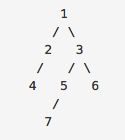- 122. 买卖股票的最佳时机 II
请向我看齐
LeetCode算法
题目分析LeetCode第122题是“买卖股票的最佳时机II”。题目描述为:给定一个数组prices,其中prices[i]是一支给定股票第i天的价格。设计一个算法来计算你所能获取的最大利润。你可以尽可能地完成更多的交易(多次买卖一支股票)。模式识别本题属于动态规划或者贪心算法的范畴。由于可以进行多次交易,且没有交易次数限制,所以可以通过比较相邻两天的价格,只要后一天价格比前一天高,就进行一次交易
- 代码随想录算法训练营第八天| 344 反转字符串、541 反转字符串II
Anjoubecoding
算法数据结构c++c语言leetcode
这两天开的是字符串专题,我准备在做题的时候用C++做一遍,再用C做一遍,因为一直刷leetcode用的都是C++,导致C的基础太薄弱了,之后工作中有可能用到C,相当于再复习复习一、Leetcode344反转字符串题目链接:Leetcode344反转字符串这道题很简单,这才是真正的简单题voidreverseString(char*s,intsSize){intleft=0,right=sSize-
- 【leetcode hot 100 39】组合总和
longii11
leetcodewindows算法
错误解法一:每一次回溯都遍历提供的数组classSolution{publicList>combinationSum(int[]candidates,inttarget){List>result=newArrayList>();Listtemp=newArrayList();intsum=0;backtrack(candidates,target,result,temp,sum);returnre
- 自用leetcode IDEA插件配置
QHG7C0
数据结构与算法(二刷)leetcode
文件名:P$!{question.frontendQuestionId}$!velocityTool.camelCaseName(${question.titleSlug})代码模版:${question.content}packageleetcode.editor.cn;//${question.title}publicclassP${question.frontendQuestionId}_$
- Swift高效解法!一文搞懂 LeetCode 236「二叉树的最近公共祖先」,助你快速拿下面试!
网罗开发
Swiftswiftleetcode面试
摘要最近公共祖先(LCA,LowestCommonAncestor)在二叉树、二叉搜索树(BST)等数据结构中有广泛应用,比如权限管理、网络路由、基因分析等。今天我们用Swift来解LeetCode236:「二叉树的最近公共祖先」,不仅会给出代码,还会分析它的时间复杂度、空间复杂度,并结合实际场景聊聊它的应用。问题描述给定一个二叉树,找到两个节点的最近公共祖先(LCA)。LCA的定义:“对于两个节
- (LeetCode 热题 100) 74. 搜索二维矩阵(二分查找)
岁忧
java版刷题LeetCode热题100LeetCodeleetcode矩阵算法c++java
题目:74.搜索二维矩阵方法一:数组按行拼接为一个不下降的一维数组。采用二分查找,时间复杂度0(lognm)。C++版本:classSolution{public:boolsearchMatrix(vector>&matrix,inttarget){intn=matrix.size(),m=matrix[0].size();intl=0,r=n*m-1;while(ltarget){r=mid-1
- Leetcode 剑指 Offer II 032. 有效的变位词
我不是程序员~~~~
C&C++leetcode算法职场和发展
给定两个字符串s和t,编写一个函数来判断它们是不是一组变位词(字母异位词)。注意:若s和t中每个字符出现的次数都相同且字符顺序不完全相同,则称s和t互为变位词(字母异位词)。示例1:输入:s="anagram",t="nagaram"输出:true示例2:输入:
- LeetCode146.LRU 缓存(哈希表+双向链表)
techpupil
缓存散列表链表
请你设计并实现一个满足LRU(最近最少使用)缓存约束的数据结构。实现LRUCache类:LRUCache(intcapacity)以正整数作为容量capacity初始化LRU缓存intget(intkey)如果关键字key存在于缓存中,则返回关键字的值,否则返回-1。voidput(intkey,intvalue)如果关键字key已经存在,则变更其数据值value;如果不存在,则向缓存中插入该组k
- (LeetCode 每日一题) 2680. 最大或值(前缀和、位运算)
岁忧
LeetCodejava版刷题leetcode算法职场和发展javac++
题目:2680.最大或值思路:在多个数上乘2,不如都在一个数上乘。这样只需要枚举每一个数乘k次2,也就是位运算移位k次。通过前缀和可以预处理出左右俩边的或值,实际上只需要预处理出一边的,另外一边在遍历时可得出。时间复杂度0(n)classSolution{public:longlongmaximumOr(vector&nums,intk){intn=nums.size();vectorv(n);f
- 图论:以二维数组表示的连通图/树应如何表示?leetcode1042.不邻接种花
坠金
技术面算法图论算法leetcode
1042.不邻接植花-力扣(LeetCode)容器在这道题中输入类似[[1,2],[3,4]],这意味着花园1连通了花园2,花园3连通了花园4。那么该怎么根据这个输入,获取一个方便后面算法的表示呢?我们通常管这种存放邻居的数据格式叫做:邻接表通常我的思路是使用下列容器作为邻接表:哈希表,key就是花园i,value是与花园i接壤的其他所有花园。二维数组,第i个数组中的元素是与花园i接壤的其他所有花
- LeetCode 热题 100_跳跃游戏 II(79_45_中等_C++)(贪心算法)
Dream it possible!
LeetCode热题100leetcodec++贪心算法算法
LeetCode热题100_跳跃游戏II(79_45)题目描述:输入输出样例:题解:解题思路:思路一(贪心选择):代码实现代码实现(思路一(贪心算法)):以思路一为例进行调试题目描述:给定一个长度为n的0索引整数数组nums。初始位置为nums[0]。每个元素nums[i]表示从索引i向后跳转的最大长度。换句话说,如果你在nums[i]处,你可以跳转到任意nums[i+j]处:0&nums){in
- 写leetcode常用的库函数和常量
xsh219
golang小知识点算法数据结构golang
在Go中刷LeetCode,以下是一些常用的标准库函数和数据类型的最大值、最小值:✅常用标准库函数数学与排序math包math.Max(x,y):返回两个float64类型数中的较大值。math.Min(x,y):返回两个float64类型数中的较小值。math.Abs(x):取绝对值。math.Pow(x,y):计算x^y。math.Sqrt(x):计算平方根。sort包sort.Ints(sl
- leetcode刷题日记——轮转数组
许_安
刷题日记leetcode算法排序算法
[题目描述]:[思路]:题目要求将一个整数数组向右轮转k个位置,右边超出的数,从左边插入因为是向右轮转k个位置,所以可以直接遍历数组,将其存放位置index加上k,但index+k可能会超出数组长度,即需要轮转到数组前面。由于数组元素个数为numsSize,也就是数组长度,我们可以通过(index+k)%numsSize取余来确定超出元素的位置运行如下voidrotate(int*nums,int
- LeetCode热题100JS(59/100)第十一天|46|78|17|39|22
Alicesflower
LeetCode热题100JSleetcodejavascript算法
46.全排列题目链接:46.全排列难度:中等刷题状态:2刷新知识:解题过程思考示例1:输入:nums=[1,2,3]输出:[[1,2,3],[1,3,2],[2,1,3],[2,3,1],[3,1,2],[3,2,1]题解分析参考题解链接:全排列放下1刷过程/***@param{number[]}nums*@return{number[][]}*///varpermute=function(num
- leetcode-50.Pow(x,n)
蒸土豆的技术细节
leetcode算法职场和发展
快速计算次方的方法。首先,先保证n是正数。如果nfloat:ifx==0:return0res=1ifn>=1returnres
- LeetCode第98题_验证二叉搜索树
@蓝莓果粒茶
算法leetcodelinux算法链表c++数据结构python
LeetCode第98题:验证二叉搜索树题目描述给你一个二叉树的根节点root,判断其是否是一个有效的二叉搜索树。有效二叉搜索树定义如下:节点的左子树只包含小于当前节点的数。节点的右子树只包含大于当前节点的数。所有左子树和右子树自身必须也是二叉搜索树。难度中等问题链接https://leetcode.cn/problems/validate-binary-search-tree/示例示例1:输入:
- 【LeetCode 热题 100】3. 无重复字符的最长子串 | python 【中等】
一只小白跳起来
leetcodejava算法开发语言
美美超过管解题目:3.无重复字符的最长子串给定一个字符串s,请你找出其中不含有重复字符的最长的长度。示例1:输入:s="abcabcbb"输出:3解释:因为无重复字符的最长子串是"abc",所以其长度为3。注意:考虑空字符串问题有重复之后要在重复的那个后面新建序列,减少时间,故需要列表储存(标准做法里用的集合捏)标准做法:把重复的set.remove(),a指针步进,没有重复的话,b指针一直步进怎
- leetcode刷题(javaScript)——栈、单调栈相关场景题总结
三月的一天
Leetcode刷题技巧总结javascriptleetcodelinux
在LeetCode刷题中,栈是一个常用的数据结构,可以帮助解决很多问题。以下是一些需要使用栈的方法,以及单调栈的应用场景:栈的使用技巧:栈常用于解决与括号匹配相关的问题,如括号序列的有效性、最长有效括号等。栈也常用于解决逆波兰表达式、表达式求值等与计算相关的问题。栈可以用于解决深度优先搜索(DFS)中的回溯问题,如组合、排列等。栈还可以用于解决某些需要“后进先出”(LIFO)特性的问题,如某些遍历
- 32.代码随想录算法训练营第三十二天|509. 斐波那契数,70. 爬楼梯,746. 使用最小花费爬楼梯
白鹭鸣鸣!
算法javadp
32.代码随想录算法训练营第三十二天|509.斐波那契数,70.爬楼梯,746.使用最小花费爬楼梯DP数组的定义以及下标的含义递推公式动态规划的初始化是很重要的遍历顺序打印数组509.斐波那契数-力扣(LeetCode)斐波那契数(通常用F(n)表示)形成的序列称为斐波那契数列。该数列由0和1开始,后面的每一项数字都是前面两项数字的和。也就是:F(0)=0,F(1)=1F(n)=F(n-1)+F(
- 【附JS、Python、C++题解】Leetcode面试150题(7)
moz与京
leetcode整理javascriptpythonc++
一、题目167.两数之和II-输入有序数组给你一个下标从1开始的整数数组numbers,该数组已按非递减顺序排列,请你从数组中找出满足相加之和等于目标数target的两个数。如果设这两个数分别是numbers[index1]和numbers[index2],则1targetIndex(vectornums,inttarget){intlength=nums.size();if(length<2){
- 【leetcode hot 100 46】全排列
longii11
leetcode算法数据结构
解法一:回溯法回溯法:一种通过探索所有可能的候选解来找出所有的解的算法。如果候选解被确认不是一个解(或者至少不是最后一个解),回溯算法会通过在上一步进行一些变化抛弃该解,即回溯并且再次尝试。用回溯算法来解决,遍历数组的每一个元素,然后尝试生成所有的排列,当生成一个完整的排列时,记录该排列,并退回到上一步,然后继续生成新的排列。就比如说“123”,我们可以先固定1,然后递归处理“23”。把“123”
- LeetCode 第30题:串联所有单词的子串
Gemini技术窝
leetcode算法数据结构java
大家好!今天我们要探讨的是一道非常有趣的字符串处理题目——LeetCode第30题:串联所有单词的子串。这个问题就像是在寻找字符串中的藏宝图,每个单词都是一个线索,我们需要把这些线索串联起来,找到它们在字符串中的位置。准备好了吗?让我们一起解锁这个问题的解决方案吧!文章目录问题描述解题思路高效代码实现详细讲解代码逻辑图解过程举例说明例子1:简单例子例子2:无匹配项例子3:重复单总结问题描述首先,让
- LeetCode每日一题——30. 串联所有单词的子串
hyk今天写算法了吗
#算法实例leetcode算法职场和发展数据结构python
文章目录题目示例思路题解题目给定一个字符串s和一些长度相同的单词words。找出s中恰好可以由words中所有单词串联形成的子串的起始位置。注意子串要与words中的单词完全匹配,中间不能有其他字符,但不需要考虑words中单词串联的顺序。示例示例1:输入:s=“barfoothefoobarman”,words=[“foo”,“bar”]输出:[0,9]解释:从索引0和9开始的子串分别是“bar
- 【LeetCode 热题100】 23. 合并 K 个升序链表的算法思路及python代码
pljnb
LeetCode热题100算法leetcode链表
23.合并K个升序链表给你一个链表数组,每个链表都已经按升序排列。请你将所有链表合并到一个升序链表中,返回合并后的链表。示例1:输入:lists=[[1,4,5],[1,3,4],[2,6]]输出:[1,1,2,3,4,4,5,6]解释:链表数组如下:[1->4->5,1->3->4,2->6]将它们合并到一个有序链表中得到。1->1->2->3->4->4->5->6示例2:输入:lists=[
- 【Leetcode刷题随笔】59 螺旋矩阵
Poor_DayDreamer
leetcode数组篇MediumTagleetcode矩阵算法
1.题目描述给定一个正整数n,生成一个包含1到n2所有元素,且元素按顺时针顺序螺旋排列的nxn正方形矩阵matrix。可结合以下原题链接阅读。原题链接:59螺旋矩阵2.解题思路本题为模拟矩阵填充过程,不需要设计算法,只要完成正确的填充过程即可。首先初始化一个nxn的二维矩阵(涉及到动态内存分配),从矩阵左上角开始往顺时针填充,关键在于填充的转角处不要重复填充,所以对于每条边都要遵循严格的统一规则,
- 【Leetcode刷题随笔】203移除链表元素
Poor_DayDreamer
leetcode链表篇leetcode链表算法
1.题目描述题意:删除链表中等于给定值val的所有节点。示例1:输入:head=[1,2,6,3,4,5,6],val=6输出:[1,2,3,4,5]示例2:输入:head=[],val=1输出:[]示例3:输入:head=[7,7,7,7],val=7输出:[]原题链接:203移除链表元素2.解题思路由于链表本身的性质,移除链表的某个节点a,只需要将前一个节点的next指针指向a的下一个节点即可
- 【Leetcode刷题随笔】844 比较含退格的字符串
Poor_DayDreamer
移除元素篇字符串篇leetcode算法职场和发展
1.题目描述给定s和t两个字符串,比较s和t是否在删除所有由#字符表示的退格操作后相等。退格操作会删除其前面(不包括#本身)的一个字符,如果前面没有字符则忽略该#。如果字符串的末尾有多个退格符,它们会相互抵消,直到没有退格符剩余或者所有字符都被删除。示例1:输入:s=“ab#c”,t=“ad#c”输出:true解释:s和t都会变成“ac”,因为#前面的b和d都被删除。示例2:输入:s=“ab##”
- 【Leetcode刷题随笔】2765最长交替子数组
Poor_DayDreamer
leetcode数组篇leetcode算法职场和发展
1.题目描述:该题目标是在一个整数数组nums中寻找最长的“交替子数组”。这种交替子数组的特点是:其元素按照“递增1,递减1,递增1…”的模式循环排列,且子数组的长度必须大于1,例如数组nums=[2,3,4,3,4],交替子数组有[2,3],[3,4],[3,4,3]和[3,4,3,4]。最长的子数组为[3,4,3,4],长度为4。详细题目描述见原题:原题。2.1解题思路一(双层循环):这道题有
- LeetCode刷题笔记
小李李李李腊八
leetcode算法java
leetcode_01两数之和斐波那契数列三个数最大乘积反转链表x的平方根环形列表LeetCode随笔两数之和给定一个整数数组nums和一个整数目标值target,请你在该数组中找出和为目标值target的那两个整数,并返回它们的数组下标。你可以假设每种输入只会对应一个答案。但是,数组中同一个元素在答案里不能重复出现。你可以按任意顺序返回答案。暴力法记录下数组第一个数值,对数组进行循环,将之后的值
- 高频SQL50题 第一天 | 1757. 可回收且低脂的产品、584. 寻找用户推荐人、595. 大的国家、1683. 无效的推文、1148. 文章浏览 I
榛果咖啡有点苦
高频SQL50题mysql
1757.可回收且低脂的产品题目链接:https://leetcode.cn/problems/recyclable-and-low-fat-products/description/?envType=study-plan-v2&envId=sql-free-50状态:已完成考点:无selectproduct_idfromProductswherelow_fats='Y'andrecyclable
- 矩阵求逆(JAVA)初等行变换
qiuwanchi
矩阵求逆(JAVA)
package gaodai.matrix;
import gaodai.determinant.DeterminantCalculation;
import java.util.ArrayList;
import java.util.List;
import java.util.Scanner;
/**
* 矩阵求逆(初等行变换)
* @author 邱万迟
*
- JDK timer
antlove
javajdkschedulecodetimer
1.java.util.Timer.schedule(TimerTask task, long delay):多长时间(毫秒)后执行任务
2.java.util.Timer.schedule(TimerTask task, Date time):设定某个时间执行任务
3.java.util.Timer.schedule(TimerTask task, long delay,longperiod
- JVM调优总结 -Xms -Xmx -Xmn -Xss
coder_xpf
jvm应用服务器
堆大小设置JVM 中最大堆大小有三方面限制:相关操作系统的数据模型(32-bt还是64-bit)限制;系统的可用虚拟内存限制;系统的可用物理内存限制。32位系统下,一般限制在1.5G~2G;64为操作系统对内存无限制。我在Windows Server 2003 系统,3.5G物理内存,JDK5.0下测试,最大可设置为1478m。
典型设置:
java -Xmx
- JDBC连接数据库
Array_06
jdbc
package Util;
import java.sql.Connection;
import java.sql.DriverManager;
import java.sql.ResultSet;
import java.sql.SQLException;
import java.sql.Statement;
public class JDBCUtil {
//完
- Unsupported major.minor version 51.0(jdk版本错误)
oloz
java
java.lang.UnsupportedClassVersionError: cn/support/cache/CacheType : Unsupported major.minor version 51.0 (unable to load class cn.support.cache.CacheType)
at org.apache.catalina.loader.WebappClassL
- 用多个线程处理1个List集合
362217990
多线程threadlist集合
昨天发了一个提问,启动5个线程将一个List中的内容,然后将5个线程的内容拼接起来,由于时间比较急迫,自己就写了一个Demo,希望对菜鸟有参考意义。。
import java.util.ArrayList;
import java.util.List;
import java.util.concurrent.CountDownLatch;
public c
- JSP简单访问数据库
香水浓
sqlmysqljsp
学习使用javaBean,代码很烂,仅为留个脚印
public class DBHelper {
private String driverName;
private String url;
private String user;
private String password;
private Connection connection;
privat
- Flex4中使用组件添加柱状图、饼状图等图表
AdyZhang
Flex
1.添加一个最简单的柱状图
? 1 2 3 4 5 6 7 8 9 10 11 12 13 14 15 16 17 18 19 20 21 22 23 24 25 26 27 28
<?xml version=
"1.0"&n
- Android 5.0 - ProgressBar 进度条无法展示到按钮的前面
aijuans
android
在低于SDK < 21 的版本中,ProgressBar 可以展示到按钮前面,并且为之在按钮的中间,但是切换到android 5.0后进度条ProgressBar 展示顺序变化了,按钮再前面,ProgressBar 在后面了我的xml配置文件如下:
[html]
view plain
copy
<RelativeLa
- 查询汇总的sql
baalwolf
sql
select list.listname, list.createtime,listcount from dream_list as list , (select listid,count(listid) as listcount from dream_list_user group by listid order by count(
- Linux du命令和df命令区别
BigBird2012
linux
1,两者区别
du,disk usage,是通过搜索文件来计算每个文件的大小然后累加,du能看到的文件只是一些当前存在的,没有被删除的。他计算的大小就是当前他认为存在的所有文件大小的累加和。
- AngularJS中的$apply,用还是不用?
bijian1013
JavaScriptAngularJS$apply
在AngularJS开发中,何时应该调用$scope.$apply(),何时不应该调用。下面我们透彻地解释这个问题。
但是首先,让我们把$apply转换成一种简化的形式。
scope.$apply就像一个懒惰的工人。它需要按照命
- [Zookeeper学习笔记十]Zookeeper源代码分析之ClientCnxn数据序列化和反序列化
bit1129
zookeeper
ClientCnxn是Zookeeper客户端和Zookeeper服务器端进行通信和事件通知处理的主要类,它内部包含两个类,1. SendThread 2. EventThread, SendThread负责客户端和服务器端的数据通信,也包括事件信息的传输,EventThread主要在客户端回调注册的Watchers进行通知处理
ClientCnxn构造方法
&
- 【Java命令一】jmap
bit1129
Java命令
jmap命令的用法:
[hadoop@hadoop sbin]$ jmap
Usage:
jmap [option] <pid>
(to connect to running process)
jmap [option] <executable <core>
(to connect to a
- Apache 服务器安全防护及实战
ronin47
此文转自IBM.
Apache 服务简介
Web 服务器也称为 WWW 服务器或 HTTP 服务器 (HTTP Server),它是 Internet 上最常见也是使用最频繁的服务器之一,Web 服务器能够为用户提供网页浏览、论坛访问等等服务。
由于用户在通过 Web 浏览器访问信息资源的过程中,无须再关心一些技术性的细节,而且界面非常友好,因而 Web 在 Internet 上一推出就得到
- unity 3d实例化位置出现布置?
brotherlamp
unity教程unityunity资料unity视频unity自学
问:unity 3d实例化位置出现布置?
答:实例化的同时就可以指定被实例化的物体的位置,即 position
Instantiate (original : Object, position : Vector3, rotation : Quaternion) : Object
这样你不需要再用Transform.Position了,
如果你省略了第二个参数(
- 《重构,改善现有代码的设计》第八章 Duplicate Observed Data
bylijinnan
java重构
import java.awt.Color;
import java.awt.Container;
import java.awt.FlowLayout;
import java.awt.Label;
import java.awt.TextField;
import java.awt.event.FocusAdapter;
import java.awt.event.FocusE
- struts2更改struts.xml配置目录
chiangfai
struts.xml
struts2默认是读取classes目录下的配置文件,要更改配置文件目录,比如放在WEB-INF下,路径应该写成../struts.xml(非/WEB-INF/struts.xml)
web.xml文件修改如下:
<filter>
<filter-name>struts2</filter-name>
<filter-class&g
- redis做缓存时的一点优化
chenchao051
redishadooppipeline
最近集群上有个job,其中需要短时间内频繁访问缓存,大概7亿多次。我这边的缓存是使用redis来做的,问题就来了。
首先,redis中存的是普通kv,没有考虑使用hash等解结构,那么以为着这个job需要访问7亿多次redis,导致效率低,且出现很多redi
- mysql导出数据不输出标题行
daizj
mysql数据导出去掉第一行去掉标题
当想使用数据库中的某些数据,想将其导入到文件中,而想去掉第一行的标题是可以加上-N参数
如通过下面命令导出数据:
mysql -uuserName -ppasswd -hhost -Pport -Ddatabase -e " select * from tableName" > exportResult.txt
结果为:
studentid
- phpexcel导出excel表简单入门示例
dcj3sjt126com
PHPExcelphpexcel
先下载PHPEXCEL类文件,放在class目录下面,然后新建一个index.php文件,内容如下
<?php
error_reporting(E_ALL);
ini_set('display_errors', TRUE);
ini_set('display_startup_errors', TRUE);
if (PHP_SAPI == 'cli')
die('
- 爱情格言
dcj3sjt126com
格言
1) I love you not because of who you are, but because of who I am when I am with you. 我爱你,不是因为你是一个怎样的人,而是因为我喜欢与你在一起时的感觉。 2) No man or woman is worth your tears, and the one who is, won‘t
- 转 Activity 详解——Activity文档翻译
e200702084
androidUIsqlite配置管理网络应用
activity 展现在用户面前的经常是全屏窗口,你也可以将 activity 作为浮动窗口来使用(使用设置了 windowIsFloating 的主题),或者嵌入到其他的 activity (使用 ActivityGroup )中。 当用户离开 activity 时你可以在 onPause() 进行相应的操作 。更重要的是,用户做的任何改变都应该在该点上提交 ( 经常提交到 ContentPro
- win7安装MongoDB服务
geeksun
mongodb
1. 下载MongoDB的windows版本:mongodb-win32-x86_64-2008plus-ssl-3.0.4.zip,Linux版本也在这里下载,下载地址: http://www.mongodb.org/downloads
2. 解压MongoDB在D:\server\mongodb, 在D:\server\mongodb下创建d
- Javascript魔法方法:__defineGetter__,__defineSetter__
hongtoushizi
js
转载自: http://www.blackglory.me/javascript-magic-method-definegetter-definesetter/
在javascript的类中,可以用defineGetter和defineSetter_控制成员变量的Get和Set行为
例如,在一个图书类中,我们自动为Book加上书名符号:
function Book(name){
- 错误的日期格式可能导致走nginx proxy cache时不能进行304响应
jinnianshilongnian
cache
昨天在整合某些系统的nginx配置时,出现了当使用nginx cache时无法返回304响应的情况,出问题的响应头: Content-Type:text/html; charset=gb2312 Date:Mon, 05 Jan 2015 01:58:05 GMT Expires:Mon , 05 Jan 15 02:03:00 GMT Last-Modified:Mon, 05
- 数据源架构模式之行数据入口
home198979
PHP架构行数据入口
注:看不懂的请勿踩,此文章非针对java,java爱好者可直接略过。
一、概念
行数据入口(Row Data Gateway):充当数据源中单条记录入口的对象,每行一个实例。
二、简单实现行数据入口
为了方便理解,还是先简单实现:
<?php
/**
* 行数据入口类
*/
class OrderGateway {
/*定义元数
- Linux各个目录的作用及内容
pda158
linux脚本
1)根目录“/” 根目录位于目录结构的最顶层,用斜线(/)表示,类似于
Windows
操作系统的“C:\“,包含Fedora操作系统中所有的目录和文件。 2)/bin /bin 目录又称为二进制目录,包含了那些供系统管理员和普通用户使用的重要
linux命令的二进制映像。该目录存放的内容包括各种可执行文件,还有某些可执行文件的符号连接。常用的命令有:cp、d
- ubuntu12.04上编译openjdk7
ol_beta
HotSpotjvmjdkOpenJDK
获取源码
从openjdk代码仓库获取(比较慢)
安装mercurial Mercurial是一个版本管理工具。 sudo apt-get install mercurial
将以下内容添加到$HOME/.hgrc文件中,如果没有则自己创建一个: [extensions] forest=/home/lichengwu/hgforest-crew/forest.py fe
- 将数据库字段转换成设计文档所需的字段
vipbooks
设计模式工作正则表达式
哈哈,出差这么久终于回来了,回家的感觉真好!
PowerDesigner的物理数据库一出来,设计文档中要改的字段就多得不计其数,如果要把PowerDesigner中的字段一个个Copy到设计文档中,那将会是一件非常痛苦的事情。

